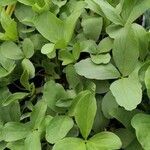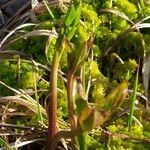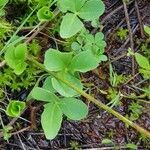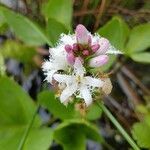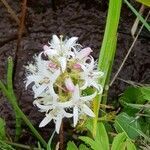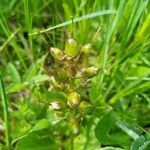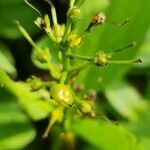Glabrous herb with stout rhizome. Petiole to c. 40 cm long in water, 5-10 cm long in drier situations; sheaths purplish. Leaflets subsessile, 5-13 × 2.5-9 cm, obovate or elliptic-obovate (lateral leaflets somewhat asymmetric); base cuneate; apex rounded or obtuse. Scape c. 20-25 cm long, 10-20-flowered. Pedicels > calyx. Calyx lobed nearly to base, c. 4 mm long; lobes narrow-triangular, obtuse. Corolla 12-14 mm long, white with pinkish flush on reverse; lobes > tube, lanceolate, reflexed, with fimbriate crest 1-3 mm long. Style 10-12 mm long; stigmatic lobes broad, appressed. Ovules 15-25. Capsule ovoid. Seed not seen in N.Z., flattened and disc-like.
A creeping plant growing from an underground stem or rhizome. These are thick and spongy. It may form dense clumps over the surface of ponds. These can be 1 m across. The leaves are divided into 3 leaflets. The leaflets are olive green. The leaf stalks sheath each other. There are long fine hairs over the spreading corolla of the flower. The flower stalk can be 25-40 cm high. It can have a dense spike of white to purplish flowers. There can be 10-20 flowers. The fruit is a capsule 6-8 mm long.
Petioles 5–30 cm, lfls emergent, short-stalked or virtually sessile, entire or wavy-margined, elliptic ovate to elliptic-obovate, 3–6 cm at anthesis, larger later; infl crowded at anthesis; pedicels 5–20 mm, sometimes 2 from one axil; cor whitish, usually purple-tinged, the tube ca twice as long as the 3–5 mm cal, the lobes lance-ovate, 5–7 mm; fr thick-walled, 6–9 mm; 2n=54, 108. In quiet shallow cold water; circumboreal, s. to N.J., Va., O., Ind., Mo., and Calif. May, June.
